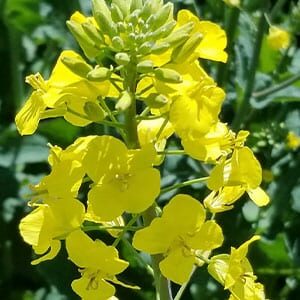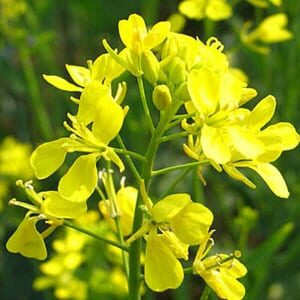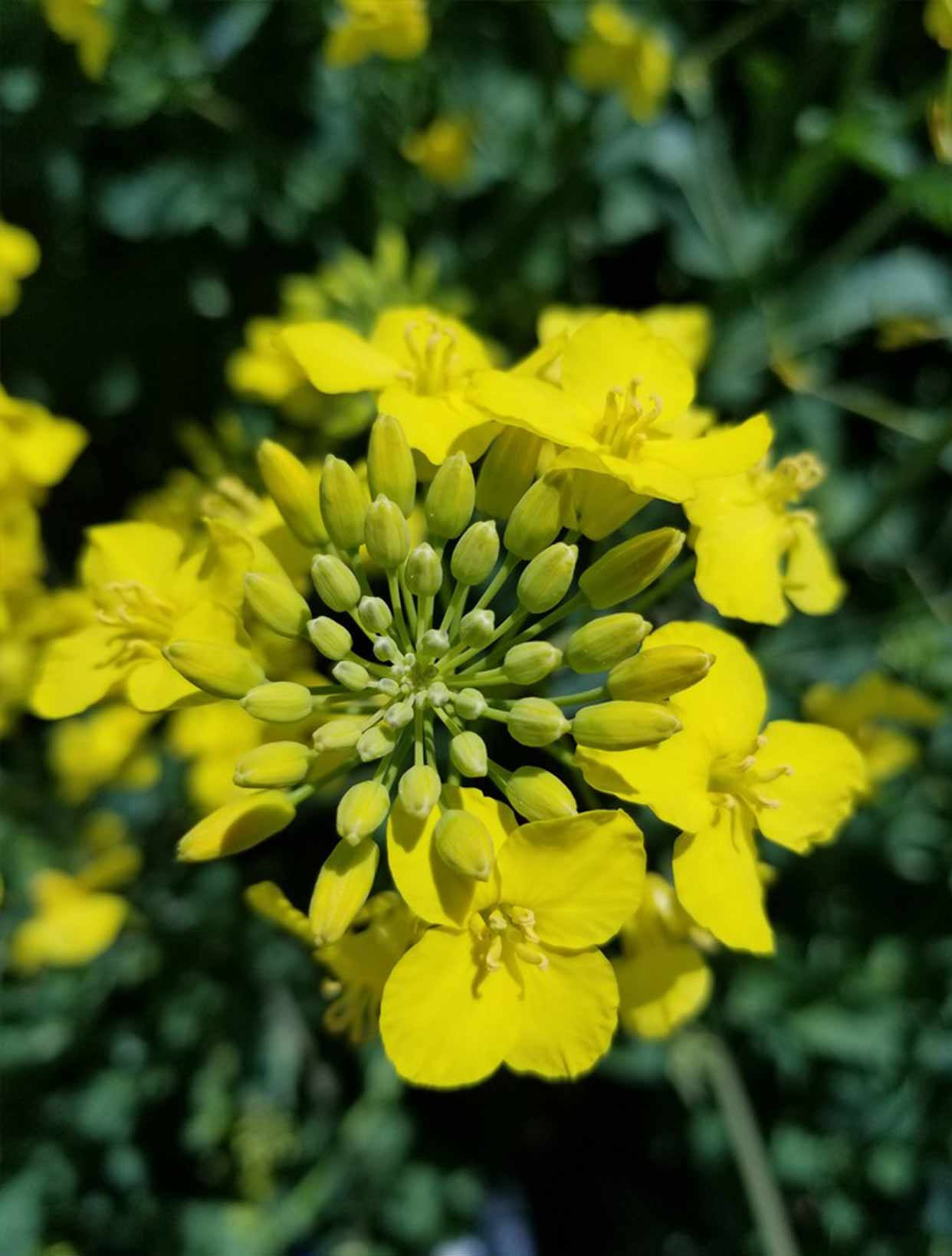What is Canola?
Canola is a broadleaf, biennial plant in the same family as mustard, broccoli, and turnips. There are both spring and winter types of canola. The plants will grow from a rosette to three to seven feet tall and produce small, bright yellow, four-petaled yellow flowers that can be seen in many areas of the Pacific Northwest from May through July. They produce pods with 20-40 seeds in each that are harvested at maturity and then crushed to create canola oil and meal. Canola seeds are small – about the size of a poppy seed. They're brownish-black in color at maturity and contain 35-45 percent oil.
How Canola is Used
Canola uses are many including for cooking and baking at home, restaurants, and food processing plants. It's a versatile oil that can be used in baking, sauteing, frying, marinating, and salad dressings. Canola oil has non-food uses as well, such as biodiesel, renewable diesel, aquaculture, and bio-plastics. Canola meal, the part left over when the seeds are crushed and the oil extracted, is highly valued for livestock feed, pet food, and fertilizer.
Canola Uses
Most vegetable oil is produced from canola seed, making canola one of the major oilseed crops grown in the world. It’s used for cooking and other products such as bread, crackers, chips, and other foods that contain vegetable oil. Canola oil is lower in saturated fats than other vegetable oils, which is one of the reasons it’s in such high demand. Its popularity is also based on the fact that it is relatively high in omega-3 and is a good source for vitamins E and K. Even cinema chains are recognizing the health components of canola with many making the switch from coconut oil to canola oil for popcorn.
Biodiesel is an alternative fuel that can be produced from renewable resources such as vegetable oil. In the United States, it’s much more common for soybean oil to be used to make biodiesel, but there is a modest amount of canola used in biodiesel in the states, mainly in the Northern Plains. In the Pacific Northwest, the Washington State ferry fleet has used biodiesel at a 5% blend (B5) since 2009, and recently committed to a 10% biodiesel blend. Annual biodiesel use by the ferry system is reported at 18 million gallons. Oregon began selling B2 biodiesel blend in 2009 and increased the blend to B5 in 2011. Several state and city ground fleets use blends up to B20 in vehicles.
In the PNW, the Renewable Energy Group has a biorefinery facility in Hoquiam, WA.
The part of the canola seed that left after extracting the oil is processed as meal for cattle, swine, poultry, and fish. Nutritional factors, including the right blend of fats, proteins, and carbohydrates needs to be taken into consideration, which is why canola meal is generally limited to 10 to 20 percent of the ration of various livestock feed mixes. In studies at WSU and in Canada, including canola meal in dairy rations increased milk production by 0.25 gallons per cow per day. Not only is canola oil high in omega-3 fatty acid, so is the meal, making it all the more attractive as a feed source. In the last few years, canola varieties have been developed with even higher omega-3 levels with the meal highly valued as a substitute for fish oil in the aquaculture industry. The Canola Council of Canada has created a website, Canolamazing, with excellent information about utilizing canola meal in livestock and fish operations.
A Healthy Alternative Canola offers many benefits, from health nutrition to improved plant yield for next year's crop.
Canola seeds are 35 to 45 percent oil and considered one of the world’s healthiest vegetable oils. The rest of the canola seed is used to produce a high-protein meal, which is excellent animal feed for cattle, poultry, swine, and fish. When fed to dairy cows, it can increase milk production by one liter per day.
Canola is also used as a biofuel feedstock, which is the feedstock of choice for Canadian-produced biodiesel because of its exceptional cold-weather performance. Compared to fossil diesel, canola biodiesel reduces lifecycle greenhouse gas emissions by 90%.
Canola oil is rich in ALA and LA fatty acids, which are essential in your diet because your body can't make them:
- Alpha-linolenic acid (ALA) is an essential omega-3 fatty acid. It protects against heart attacks and strokes by helping to lower bad cholesterol.
- Linoleic acid (LA) is an essential omega-6 fatty acid. It's important for the brain and for the growth and development of infants.
Compared to all other vegetable oils on the market, canola oil has the lowest levels of the fats that are "bad" for human health:
- Canola oil has the lowest saturated fat level of all vegetable oils, even lower than olive oil, which contains twice as much saturated fat as canola oil. Saturated fats have been linked to coronary heart disease and an increase in bad cholesterol (LDL) in your body.
- Canola oil is defined as zero trans fat by government regulatory authorities in North America. Trans fats raise bad cholesterol and lower good cholesterol (HDL).
Canola is free of cholesterol - a soft, waxy substance present in all parts of your body. Too much LDL or "bad" cholesterol can clog arteries and increase the risk of heart attack and stroke.
Vitamin E is an antioxidant that may help protect the heart; however, most American adultss do not get enough Vitamin E from their dietary intake. Just one serving of canola oil provides 16 percent of the recommended daily intake of vitamin E for adults.
Why Do Farmers Spray Chemicals on Canola?
When farmers apply chemicals to a canola field, they are controlling weeds, diseases, or insect pests. Just like homeowners, farmers are required to follow the instructions on the labels of every herbicide and pesticide they use, and the chemical is specifically for what they are controlling. Did you know when you see a sprayer in a field, the majority of the liquid you see is water? The amount of chemical applied is typically the equivalent of a can of soda (or less) spread out in an area the size of a football field! Be sure to check out our Production Strategies page for more information.
Is it Canola, Mustard, or Yellow Sweet Clover?
Canola belongs to the same family as mustard, broccoli, Brussels sprouts, and cauliflower. Canola, mustard, and yellow sweet clover all have that characteristic bright yellow flower. It's not easy to tell them apart from a distance, but when you get up close, here's the difference:

CANOLA
Canola plants are from three to five feet tall. Stems are hairless and smooth. Canola has long, narrow pods with a smooth, medium conical peak. The pods are usually positioned at a right angle to the stem. Canola seeds are brownish-black in color and spherical to oval in shape. They are larger than brown and oriental mustard, but smaller than yellow mustard seeds.

MUSTARD
Mustard is a plant species in the genera Brassica and Sinapis in the family Brassicaceae. Its flowers are smaller than the canola flower. Stems are pubescent with lots of small hairs on the stems and petioles. The pods are long, flat, and covered with small hairs. The pods are positioned at a right angle to the stem. Mustard seeds are light creamy yellow to yellow with the occasional seed being light or yellowish-brown. The seeds are spherical or oval in shape with a diameter of 2-3mm.

YELLOW SWEET CLOVER
Yellow sweet clover is a species of legume and is four to six feet high at maturity. Leaves alternate on the stem and possess three leaflets. Yellow flowers bloom in spring and summer and produce fruit in pods typically containing one seed. Seeds can be viable for up to 30 years. Plants have large taproots and tend to grow in groups. Plants have a characteristic sweet odor.

